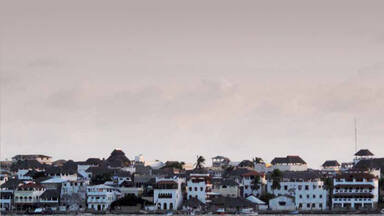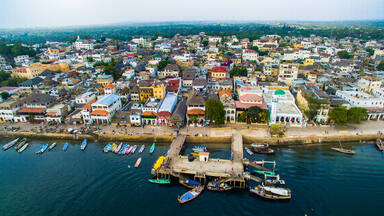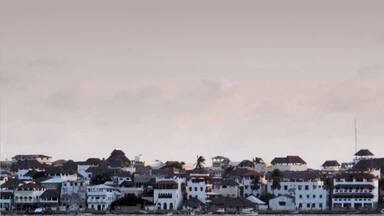Lamu Old Town
Lamu Old Town
Lamu Old Town is the oldest and best-preserved Swahili settlement in East Africa, retaining its traditional functions. Built in coral stone and mangrove timber, the town is characterized by the simplicity of structural forms enriched by such features as inner courtyards, verandas, and elaborately carved wooden doors. Lamu has hosted major Muslim religious festivals since the 19th century, and has become a significant centre for the study of Islamic and Swahili cultures.
Description is available under license CC-BY-SA IGO 3.0
Vieille ville de Lamu
La vieille ville de Lamu, qui est le plus ancien et le mieux préservé des lieux de peuplement swahilis en Afrique de l'Est, conserve ses fonctions traditionnelles. Construite en roches coralliennes et de bois de palétuvier, la ville se caractérise par la simplicité de ses formes structurelles, enrichies d'éléments comme des cours intérieures, des vérandas et des portes de bois sculptées avec soin. Siège depuis le XIXe siècle de grandes célébrations religieuses, Lamu est devenue un centre important pour l'étude des cultures islamique et swahilie.
Description is available under license CC-BY-SA IGO 3.0
مدينة لامو القديمة
لا تزال مدينة لامو القديمة تحافظ على عاداتها التقليديّة وهي أقدم المناطق التي سكنتها الشّعوب السواحليّة في أفريقيا الشرقيّة وأكثر مدينة قد تمَّت المحافظة عليها. بُنيت هذه المدينة من صخورٍ مرجانيّةٍ ومن خشب الشورى وتتميّز ببساطة أشكال أبنيتها الغنيّة بعناصرَ مثل الساحات الداخليّة والشرفات والأبواب الخشبيّة المنقوشة بدقة. ومنذ القرن التاسع عشر، شكّلت لامو مركزًا للاحتفالات الدينيّة الكبرى، كما أصبحت مركزًا مهمًّا لدراسة الثقافات الاسلاميّة والسواحلية.
source: UNESCO/CPE
Description is available under license CC-BY-SA IGO 3.0
拉穆古镇
拉穆古镇是东非最古老、保存最完整的斯瓦希里人聚居地,并仍然保持着它的传统作用。这个镇用珊瑚石和红树林木材建造而成,以简朴的结构为特色,同时,庭院、阳台走廊、精心雕刻的木门为其增添了很多特有风貌。从19世纪开始,主要的穆斯林宗教节日活动都在这里举行,这里也已经成为伊斯兰和斯瓦希里文化的重要研究中心。
source: UNESCO/CPE
Description is available under license CC-BY-SA IGO 3.0
Старый город в Ламу
Старый город в Ламу – это старейшее и наиболее хорошо сохранившееся поселение суахили в Восточной Африке, продолжающее выполнять свои традиционные функции. Построенный из кораллового известняка и мангровой древесины, город характерен простотой строительных форм, которые обогащены такими элементами как внутренние дворики, веранды и искусно украшенные резьбой деревянные двери. В Ламу, начиная с XIX в., проводятся крупные мусульманские религиозные праздники, и он превратился в важный центр изучения культур ислама и суахили.
source: UNESCO/CPE
Description is available under license CC-BY-SA IGO 3.0
Ciudad vieja de Lamu
La ciudad vieja de Lamu no sólo es el más antiguo y el mejor conservado de los lugares de poblamiento swahilíes del África Oriental, sino que además ha conservado sus funciones tradicionales. Construida con roca de coral y madera de mangle, la ciudad se caracteriza por la simplicidad de sus formas estructurales, enriquecidas por elementos como patios interiores, galerías y puertas de madera primorosamente esculpidas. Sede de grandes celebraciones religiosas desde el siglo XIX, Lamu se ha convertido en un centro importante de estudio de la cultura islámica y la swahili.
source: UNESCO/CPE
Description is available under license CC-BY-SA IGO 3.0
ラム旧市街
ケニア南東部の港町で、インド洋西端部、アフリカ大陸沿岸部のラム群島中のラム島北東部に位置する。もともとペルシアの植民地でザンジバルの土侯の支配下にあったが、19世紀末まではモンバサと並んで、黄金・象牙・奴隷などの集散地として繁栄した。旧市街は東アフリカで最古のスワヒリの居住地であり、その伝統的な様式をよく保存している。19世紀以来、重要な宗教儀式を執り行い、イスラムとスワヒリ文化研究の宝庫となっている。source: NFUAJ
Oude stad van Lamu
De Oude stad van Lamu ligt op een eiland met dezelfde naam, 350 kilometer ten noorden van Mombasa. Het is het oudste en best bewaarde voorbeeld van een Swahili nederzetting in Oost-Afrika, met behoud van traditionele functies. De stad is gebouwd van koraalsteen en mangrove hout. De Swahili huizen zijn eenvoudig en uniform aan de buitenkant, maar hebben uitvoerig uitgesneden en versierde houten deuren, kenmerkend voor Lamu. De eenvoudige (bouw)structuren van de stad zijn verder verrijkt met binnenplaatsen en veranda’s. Lamu heeft belangrijke islamitische religieuze festivals gehouden sinds de 19e eeuw en is uitgegroeid tot een belangrijk centrum voor de bestudering van islamitische en Swahili culturen.
Source: unesco.nl
Outstanding Universal Value
Brief synthesis
Lamu Old Town, located on an island known by the same name on the coast of East Africa some 350km north of Mombasa, is the oldest and best preserved example of Swahili settlement in East Africa.
With a core comprising a collection of buildings on 16 ha, Lamu has maintained its social and cultural integrity, as well as retaining its authentic building fabric up to the present day. Once the most important trade centre in East Africa, Lamu has exercised an important influence in the entire region in religious, cultural as well as in technological expertise. A conservative and close-knit society, Lamu has retained its important status as a significant centre for education in Islamic and Swahili culture as illustrated by the annual Maulidi and cultural festivals.
Unlike other Swahili settlements which have been abandoned along the East African coast, Lamu has continuously been inhabited for over 700 years.
The growth and decline of the seaports on the East African coast and interaction between the Bantu, Arabs, Persians, Indians, and Europeans represents a significant cultural and economic phase in the history of the region which finds its most outstanding expression in Lamu Old Town, its architecture and town planning.
The town is characterized by narrow streets and magnificent stone buildings with impressive curved doors, influenced by unique fusion of Swahili, Arabic, Persian, Indian and European building styles. The buildings on the seafront with their arcades and open verandas provide a unified visual impression of the town when approaching it from the sea. While the vernacular buildings are internally decorated with painted ceilings, large niches (madaka), small niches (zidaka), and pieces of Chinese porcelain. The buildings are well preserved and carry a long history that represents the development of Swahili building technology, based on coral, lime and mangrove poles.
The architecture and urban structure of Lamu graphically demonstrate the cultural influences that have come together over 700 hundred years from Europe, Arabia, and India, utilizing traditional Swahili techniques that produced a distinct culture. The property is characterized by its unique Swahili architecture that is defined by spatial organization and narrow winding streets. This labyrinth street pattern has its origins in Arab traditions of land distribution and urban development. It is also defined by clusters of dwellings divided into a number of small wards (mitaa) each being a group of buildings where a number of closely related lineages live.
Attributed by eminent Swahili researchers as the cradle of Swahili civilization,Lamu became an important religious centre in East and Central Africa since the 19th century, attracting scholars of Islamic religion and Swahili culture. Today it is a major reservoir of Swahili culture whose inhabitants have managed to sustain their traditional values as depicted by a sense of social unity and cohesion.
Criterion (ii):The architecture and urban structure of Lamu graphically demonstrate the cultural influences that have come together there over several hundred years from Europe, Arabia, and India, utilizing traditional Swahili techniques to produce a distinct culture.
Criterion (iv):The growth and decline of the seaports on the East African coast and interaction between the Bantu, Arabs, Persians, Indians, and Europeans represents a significant cultural and economic phase in the history of the region which finds its most outstanding expression in Lamu Old Town.
Criterion (vi):Its paramount trading role and its attraction for scholars and teachers gave Lamu an important religious function (such as the annual Maulidi and Lamu cultural festivals) in East and Central Africa. It continues to be a significant centre for education in Islamic and Swahili culture.
Integrity
The property, covering 16 hectares, adequately incorporates all the tangible and intangible attributes that convey its outstanding universal value. A high percentage (65%) of the physical structures is in good condition with only 20 % being in need of minor refurbishment. The remaining 15 % may need total restoration. The majority of the town’s buildings are still in use.
The town needs to maintain its relationship with the surrounding landscape. The setting of the Old Town is vulnerable to encroachment and illegal development on the Shela dunes that are a fundamental part of its setting. Development is a threat to its visual integrity as an island town closely connected to the sea and sand-dunes, and to its ultimate survival in terms of the fresh water that the dunes supply. The setting extends to the surrounding islands, all of which need to be protected from informal settlements, and to the mangroves that shelter the port.
Authenticity
The architecture of Lamu has employed locally available materials and techniques which are still applied to date. The people of Lamu have managed to maintain age-old traditions reinforcing a sense of belonging and social unity. This is expressed by the layout of the town which includes social spaces such as porches (Daka), town squares and sea front barazas. The town continues to be a significant centre for education in Islamic and Swahili culture.
The authenticity of the Old Town is vulnerable to development and to a lack of adequate infrastructure, that could overwhelm the sensitive and comparatively fragile buildings and urban spaces that together make up the distinctive urban grain of the town.
Protection and management requirements
Lamu Old Town is managed by the National Museums and Heritage Act 2006 (that replaced the 1983 National Museums Act CAP 216 and Antiquities and Monuments Act CAP 215) and the Local Governments Act (and the associated by laws). Physical construction is also subjected to the EMCA Act and the 2006 Planning Act, which recognize that archaeology is material for consideration. The Old Town has a gazetted buffer zone that includes the Manda and Ras Kitau mangrove skyline and the Shela sand dunes, also protected by the Forest Act and Water Act respectively (although the buffer zone has not been formally approved by the World Heritage Committee). All the components are legally protected.
The Lamu Stone Town Conservation Office, now renamed the Lamu World Heritage Site and Conservation Office, was established by the National Museums of Kenya and has been in operation since 1986. A conservation officer is seconded to Lamu County Council to advice on conservation matters. A planning commission exists since 1991 to play a supervisory role and address emerging issues in the conservation area.
There exists a conservation plan for Lamu Old Town which is used as a guide in balancing the community needs for development and sustaining the architectural values of the town. The property is in a satisfactory state of conservation. Locally embedded institutions ensure the continued importance of Lamu as a centre of Islamic and Swahili cultural learning and practices.
A draft management plan has been developed that will address issues such as the mushrooming of informal settlements in the setting of the property, encroachment and illegal development on the sand dunes water catchment area, the proposed port and cruise ship berth, and oil exploration. The plan will also strengthen the inter-ministerial relationships to enhance an integrated management approach, including the establishment of a conservation fund, for sustainable conservation and management of the property.







